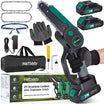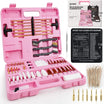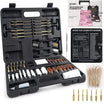As the fall season settles in, it’s time to start preparing your fruit trees for the colder months ahead. Proper fall care, including pruning and winterizing, not only ensures the health of your trees but also helps them produce better yields in the coming spring. Here's a comprehensive guide to caring for your fruit trees in fall, designed to help you maintain a thriving garden.
Why Fall Pruning Matters for Fruit Trees
Pruning fruit trees in the fall is essential for maintaining tree health and enhancing fruit production. While heavy pruning is often reserved for late winter or early spring, a light trim in fall can be beneficial. Here’s why:
- Disease Prevention: Removing dead or diseased branches in fall reduces the risk of infections spreading over winter.
- Improved Airflow: Thinning out dense branches allows for better air circulation, which can help prevent moisture buildup and fungal diseases.
- Enhanced Structure: Pruning in fall helps maintain the shape of the tree, making it more resistant to wind damage and snow accumulation during winter.
How to Prune Your Fruit Trees in Fall
Follow these steps to ensure effective fall pruning:
-
Inspect Your Trees:
Before pruning, take a close look at your trees. Identify any branches that appear dead, diseased, or damaged. Also, look for branches that cross each other or seem overly dense. -
Use Sharp Tools:
Make sure your pruning shears or saws are sharp. This will ensure clean cuts, which heal faster and reduce the risk of infection. -
Cut at an Angle:
When removing branches, make cuts at a 45-degree angle to allow water runoff. This minimizes the risk of decay and disease at the cut site. -
Remove Weak or Dead Branches First:
Start by cutting off any dead or weakened branches. This not only improves the tree’s appearance but also reduces stress on the tree. -
Thin Out Dense Areas:
If branches are growing too closely together, thin them out to improve light penetration and airflow. This will also make the tree more resilient to heavy snow and ice accumulation. -
Avoid Heavy Pruning:
While it’s tempting to give your tree a major trim, heavy pruning is best done in late winter. In fall, focus only on removing what’s necessary to promote tree health.
Winterizing Fruit Trees: Essential Steps
Once you’ve completed fall pruning, it’s time to winterize your fruit trees to protect them from harsh winter conditions. Here’s how:
-
Apply Mulch:
Spread a layer of mulch around the base of the tree, but not directly against the trunk. Mulch helps insulate the roots, retaining moisture and protecting them from freezing temperatures. -
Wrap the Trunk:
Use tree wrap or burlap to cover the trunk, especially for young trees. This provides an extra layer of protection against freezing and cracking caused by temperature fluctuations. -
Water Deeply Before the First Freeze:
Before the ground freezes, give your trees a deep watering. This ensures that the roots have enough moisture to withstand the dry winter months. -
Protect Branches from Heavy Snow:
If you live in an area prone to heavy snowfall, consider wrapping the branches loosely with burlap or using a tree guard. This can help prevent branches from breaking under the weight of snow and ice. -
Add Wind Barriers:
For young or newly planted trees, consider adding a wind barrier to shield them from harsh winter winds. You can use stakes and burlap to create a simple, protective screen around the tree. -
Inspect Regularly:
Throughout the winter, check your fruit trees periodically for signs of damage or disease. Remove any fallen branches, and ensure that mulch and tree wraps are still intact.
Additional Tips for Healthy Fruit Trees in Fall
- Fertilize Appropriately: While fertilizing is usually done in spring, a light application of compost in fall can enrich the soil and support root health over winter.
- Prevent Pests: Keep an eye out for pests like aphids or scale, which can cause damage even in cooler weather. Apply horticultural oil to deter overwintering pests.
- Rake Fallen Leaves: Clean up fallen leaves around the base of the tree to prevent pests and diseases from harboring over winter. Leaves can also be added to the compost pile.
Conclusion
Proper fall care for fruit trees is vital to ensure their health and productivity. By focusing on light pruning and effective winterization, you set the stage for a successful growing season next year. Take the time this fall to give your fruit trees the care they need, and you’ll be rewarded with healthier growth and abundant fruit production in the spring.























Leave a comment
All comments are moderated before being published.
This site is protected by hCaptcha and the hCaptcha Privacy Policy and Terms of Service apply.